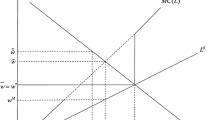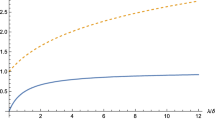Abstract
I propose and estimate a structural model of the labor market that features agents who are heterogeneous in both productivity and reservation wages, and a monopsony employer bound by the minimum wage. I examine the consequences of alternative minimum wage regimes. My results indicate that under a $15 federal minimum wage, at least 1.58 million lower-skilled women aged between 24 and 55 who worked for less than $15 per hour in 2017 would lose their jobs and be involuntarily excluded from labor market participation. The remaining 11.21 million would see their wage rise to the new minimum. The $15 minimum would also encourage an additional 2.74 million women to enter the labor force.





Similar content being viewed by others
Notes
It is well known that an exclusion restriction is necessary to identify a standard Roy model. See, e.g., French and Taber (2010)
Huber and Mellace (2012) tested the validity of this variable as an exclusion restriction. In eight empirical applications, their tests did not find the instrument invalid.
Data on state minimum wages are taken from U.S. Department of Labor (2017). Because workers can more easily commute between localities than between states, I do not take into account local minimum wage policies, such as the $15 Seattle minimum wage.
The four states are Arizona, California, Massachusetts, and Washington.
The East South Central division comprises Alabama, Mississippi, Tennessee, and Kentucky. The West North Central division includes the Dakotas, Nebraska, Kansas, Minnesota, Missouri, and Iowa.
Recall that workers in the model are involuntarily unemployed only if they would be willing to work at the latent wage but are worth less than the minimum wage to the firm - i.e., if \(w^{\star }\left (z\right ) > y\) and z < m.
References
Alesina A, Algan Y, Cahuc P, Giuliano P (2015) Family ties and the regulation of labor. J Eur Econ Assoc 13:599–613
Aschenfelter O, Farber H, Ransom M (2010) Labor market monopsony. J Labor Econ 28:203–210
Autor D, Manning A, Smith C (2016) The contribution of the minimum wage to US wage inequality over three decades: A reassessment. Am Econ J Appl Econ 8:58–99
Bhaskhar V, To T (1990) Minimum wages for ronald McDonald monpsonies: A theory of monopolistic competition. Econ J 109:190–203
Burdett K, Mortensen D (1998) Wage differentials, employer size, and unemployment. Int Econ Rev 38:257–273
Butcher T, Dickens R, Manning A (2012) Minimum wages and inequality: Some theory and an application to the UK. CEP Discussion Paper 1177
Card D, Kreuger A (1994) Minimum wages and employment: A case-study of the fast-food industry in New Jersey and Pennsylvania. Am Econ Rev 84:772–793
Cengiz D, Dube A, Lindner A, Zipperer B (2019) The effect of minimum wages on low-wage jobs. Q J Econ 134:1405–1454
Doyle J (2006) Employment effects of a minimum wage: a density discontinuity design revisited. MIT, Cambridge MA
Dube A, Lester T, Reich M (2010) Minimum wage effects across state borders: Estimates using contiguous counties. Rev Econ Stat 92:945–964
Dube A, Naidu S, Reich M (2007) The economic effects of a citywide minimum wage. Ind Labor Relat Rev 60:522–543
Fairris D, Bujanda L (2008) The dissipation of minimum wage gains for workers through labor-labor substitution. South Econ J 75:473–496
Flinn C (2006) Minimum wage effects on labor market outcomes under search, matching, and endogenous contract rates. Econometrica 74:1013–1062
Flood S, King M, Ruggles S, Warren JR (2015) Integrated public use microdata series, current population survey: Version 4.0. Machine-readable database. www.cps.ipums.org. University of Minnesota
French E, Taber C (2010) Identification of models of the labor market. In: Ashenfelter O, Card D (eds) Handbook of labor economics, vol 4a. Elsevier Science B. V, Amsterdam
Giuliano L (2013) Minimum wage effects on employment, substitution, and the teenage labor supply: evidence from personnel data. J Lab Econ 31:155–194
Heckman J, Honoré B (1990) The empirical content of the Roy model. Econometrica 58:1121–1149
Huber M, Mellace G (2012) Testing instrument validity in sample selection models. University of St. Gallen, Discussion Paper 2011–45
Jales H (2018) Estimating the effects of the minimum wage in a developing country: a density discontinuity design approach. J Appl Econ 33:29–51
Maasoumi E, Wang L (2019) The gender gap between earnings distributions. J Polit Econ 127:2438– 2504
Machado C (2017) Unobserved selection heterogeneity and the gender wage gap. J Appl Econ 32:1348–1366
Manning A (2003) Monopsony in motion princeton. Princeton University Press, Princeton NJ
Mendez F, Sepulveda F (2019) Monopsony power in occupational labor markets. J Labor Res 40:387–411
Meyer R, Wise D (1983) The effects of the minimum wage on the employment and earnings of youth. J Labor Econ 1:66–100
Mulligan CB, Rubinstein Y (2008) Selection, investment, and women’s relative wages over time. Q J Econ 123:1061–1110
Schmitt J (2003) Creating a consistent hourly wage series from the current population survey’s outgoing rotation group, 1979-2002. Unpublished manuscript center for economic and policy research Washington DC
U.S. Census Bureau (1994) Geographic areas reference manual
U.S. Congressional Budget Office (2019) The effects on employment and family income of increasing the minimum wage. www.cbo.gov/publication/55410
U.S. Department of Labor Wage and Hour Division (2017) State minimum wage laws. www.dol.gov/whd/minwage/america.htm
Wooldridge J (2007) Econometric analysis of cross section and panel data. MIT Press
Acknowledgements
I am grateful to Javier Birchenall, David Green, Marek Kapicka, John Krieg, Mark Long, Julian Neira, Charlie Nusbaum, Krishna Pendakur, Peter Rupert, Keven Schnepel, Jacob Vigdor, and two anonymous referees for helpful comments and suggestions.
Funding
No funding was received for conducting this study.
Author information
Authors and Affiliations
Corresponding author
Ethics declarations
Conflict of Interests
The author has no relevant financial or non-financial interests to disclose.
Additional information
Publisher’s Note
Springer Nature remains neutral with regard to jurisdictional claims in published maps and institutional affiliations.
Appendices
Appendix A: Data Appendix
The data are from the merged outgoing rotation groups (ORG) of the twelve monthly Current Population Surveys conducted by the Bureau of Labor Statistics in 2017. The CPS data are made available by both IPUMS at the Minnesota Population Center Flood et al. (2015) and by NBER. Households selected into the CPS are surveyed eight times, over four consecutive months in two consecutive years. The outgoing rotation group in each month consists of all the households surveyed for either the fourth or eighth time. Certain questions about employment and earnings are only asked to members of an ORG. These are called the “earner study” questions. Individuals are eligible for the earner study if they are older than 15 and employed as a wage or salary worker (i.e., not self-employed).
For each employed, civilian adult in the survey, the data include the number of hours usually worked per week at the main job. For everyone in the earner study, the data also include weekly earnings. To determine weekly earnings, people are first asked their pay periodicity, either hourly, weekly, monthly, or on some other basis, and then for their earnings on that basis. Those who report that they are paid hourly are then asked the number of hours per week they work at that rate. Weekly earnings for those paid hourly are the hourly rate times the number of hours worked per week, plus any usual weekly overtime pay, tips, and commissions (OTC). For all others, weekly earnings are annualized pay including OTC divided by 52. Workers who report a non-hourly wage frequency are asked if they are paid at an hourly rate nonetheless, and if so, what the hourly rate is.
A large fraction of the people surveyed do not respond to questions about their earnings. The BLS replaces missing data with an “allocated” value from a randomly selected respondent with similar demographic and work characteristics.
My sample is drawn from women in the ORGs aged between 24 and 55 who have an associate degree or less. There are 49,689 such records. I consider a worker to be anyone eligible for the earner study who works at least five hours per week. Of these, I drop 73 observations of workers who either (1) usually work zero hours per week at the main job, (2) are paid on an hourly basis and either work zero hours at the specified hourly rate or are paid $0 per hour, or (3) earn $0 per week on a non-hourly basis.
I determine an hourly wage for each worker. For those who report an hourly wage and who do not receive OTC, I use the reported value. Since weekly earnings include OTC but the hourly wage does not, for all other workers I use the ratio of weekly earnings and the usual number of hours worked per week. Among respondents who report that their weekly hours vary, I set usual hours to 40 and 20 for those who work full and part-time, respectively.
To eliminate implausibly high or low hourly wages, following common practice as reported in (Schmitt 2003), I drop 4 observations with wages above $150.00 per hour, and 47 with wages less than or equal to $1 per hour. Weekly earnings in the data are topcoded at $2884.61, and hourly wages are topcoded at $99.99. The sample contains 99 observations with topcoded earnings. Following (Schmitt 2003), I multiply topcoded earnings by 1.4 times the topcode.
The final sample contains information about 49,565 women, of whom 30,128 are workers. For 11,538 of them, the hourly wage is drawn from allocated data. I retain these observations because I am concerned with both the distribution of earnings and labor force participation, and 38.3% of all workers have allocated wages.
Appendix B: Proof of Proposition 1
The proof relies on the following properties of the Gaussian Inverse Mills Ratio, \(\lambda \left (x\right ) = \frac {\displaystyle \phi \left (x\right )}{\displaystyle {\Phi }\left (x\right )}\), which are established in Heckman and Honoré (1990).
The first order condition in Eq. 2 can be rewritten as follows:
where
Since \(\lambda \left (x\right )\) is a decreasing function with range \(\left (0,\infty \right )\), given any Z, \(g\left (W,Z\right )\) is an increasing function in W with range \(\left (-\infty ,\infty \right )\). This implies that \(W\left (Z\right )\) exists for all Z, and that \(\frac {\partial W}{\partial Z} < 0\) if and only if \(g_{Z}\left (W,Z\right ) > 0\), where gZ is the partial derivative of \(g\left (W,Z\right )\) with respect to Z. Differentiating Eq. 15, we get
where the function \(h\left (x\right )\) is defined as follows:
Using Eqs. 11 through 13, we can show that
This implies that if ρ ≥ 0, then \(g_{Z}\left (W,Z\right ) < 0\) and so \(\frac {\displaystyle \partial W}{\displaystyle \partial Z} > 0\).
Now suppose that ρ < 0. Then, Eqs. 18 to 20 imply that \(g_{Z}\left (W,Z\right )\) is increasing in W, and that there exists a function \(W_{0}\left (Z\right )\) defined as follows:
Note that \(\frac {\displaystyle \partial W}{\displaystyle \partial Z} < 0\) if and only if \(g\left (W_{0}\left (Z\right ),Z\right ) < 0\). Using Eqs. 17 and 16, we find that
Substituting this into Eq. 15, we find that \(g\left (W_{0}\left (Z\right ),Z\right )\) is a linear, decreasing function of Z. So define Z0 as follows:
If Z > Z0, then \(g\left (W_{0}\left (Z\right ),Z\right ) < 0\), and so \(\frac {\displaystyle \partial W}{\displaystyle \partial Z} < 0\). If Z < Z0, then \(g\left (W_{0}\left (Z\right ),Z\right ) > 0\), which implies that \(\frac {\displaystyle \partial W}{\displaystyle \partial Z} > 0\).
Appendix C: Table 1
Rights and permissions
About this article
Cite this article
Martin, D.D. The Minimum Wage in a Roy Model with Monopsony. J Labor Res 42, 358–381 (2021). https://doi.org/10.1007/s12122-021-09320-z
Accepted:
Published:
Issue Date:
DOI: https://doi.org/10.1007/s12122-021-09320-z




